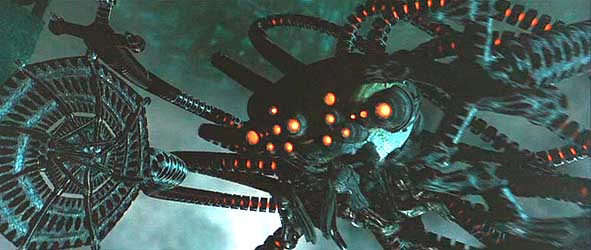
Recently, the issue of the future of Wi-Fi networks is increasingly being discussed in connection with the expected mass construction of fifth-generation cellular networks. Indeed, why do we need Wi-Fi in a world where cellular networks provide billions of people with high-speed Internet access? Will the family of Wi-Fi standards stop developing with the advent of 5G? Will technology leave the market, completing its “historic mission”? Everyone who answered these questions in the affirmative, is dedicated to this article. We hope that everyone else who understands network technology will also be interested in reading.
SpoilerWe decided to illustrate the text on the “struggle” of the two technologies with cadres from the immortal “Matrix” trilogy, in which the struggle between cars and people ended in a coexistence.
Despite the apparent importance and consistency, the questions about the competition between Wi-Fi and 5G are built on the artificial opposition of related in essence, but different in the models of application of technology. Most of the claims about the fragility of Wi-Fi belongs to representatives of mobile operators, at the end of the article we
will tell you why .
In the meantime, let's try to dispel two misconceptions together - “5G is much faster than Wi-Fi” and “Wi-Fi will die very soon”. First, let's go back to the past and see what 5G is and what is Wi-Fi.
Frequency hunger
5G is a new generation of cellular communication standards, which, as many believe, will make a new revolution in telecommunications. Meanwhile, a similar view on 4G at one time was, perhaps, more justified. Compared to 3G 4G, the data transmission speed has increased by an order of magnitude, the technology has received a completely new radio interface, a new backbone architecture and a lot of new features for operators (and, as a result, for subscribers). In the case of 5G, there are also a lot of changes and improvements, and some of them are quite radical. But there is one important fact that is rarely talked about:
on the basis of the 5G standards, cellular networks of three different categories will be created . These are 5G networks for traditional cellular network usage scenarios in the 1-6 GHz bands, networks for continuous coverage of the territory and the Internet of Things (IoT) at frequencies below 1 GHz, and the millimeter-band network. And only the first of these three types of 5G will be widely available for regular mobile subscribers in the foreseeable future. The remaining two species will have special usage patterns, which we will also discuss.

But first about the burning one - about the “supersonic speeds” for subscribers. 5G networks operating in the more or less familiar frequency bands from 1 to 6 GHz will be intended for mass service of ordinary subscribers. At higher frequencies, it is almost impossible to provide a complete coverage with the help of a limited number of powerful base stations (macro cells). Unfortunately, there are few free frequencies below 6 GHz, and this is a worldwide problem. With 3G and 4G, we have already passed and continue to undergo the conversion of parts of the spectrum, the transfer of various kinds of consumers to other frequency areas, in the future the refarming of frequencies from older standards to newer ones. Obviously, there is no magic new source of free frequencies for 5G in the usual ranges. Actually, a large group of new 5G solutions is aimed at alleviating the problem of lack of frequency resource. The purpose of new ideas and technologies in cellular communication is always to increase the capacity and speed of the network without a significant increase in its cost. What exactly can you think of to get closer to this goal? And what exactly does 5G offer for this?
Wi-Fi to the rescue
To increase the capacity and speed of the network could get new frequencies. As already mentioned, there is nowhere to take them, so cellular communication is trying to reach the ranges that are occupied by other technologies. In 5G
, cellular phone use methods of Wi-Fi frequencies , which already have a number of 4G implementations, are developing further. For Wi-Fi in the world, rather large portions of the spectrum (hundreds of megahertz) are allocated in the 1-6 GHz band, and mobile operators have been “hunting” for a long time.
But it’s impossible to simply pick up these frequencies from public networks, therefore a family of technologies is being developed that allows using these frequencies simultaneously for Wi-Fi and cellular communication, and without significant harm to the quality of Wi-Fi. This is an interesting trend. From simple reuse of common band in LTE-U technology (poorly coordinated and harmful to Wi-Fi), development went first to LAA technology (supported by 3GPP Release 13), which uses Listen Before Talk (LBT) principle, and then to LWA and eLAA standards. They no longer simply determine the way of sharing, but also describe the direct coordination technique (through integration and data exchange) of Wi-Fi and cellular radio subsystems (supported with Releases 13 and 14, respectively). The most important thing here is the trend of
coordination and cooperation of cellular networks and Wi-Fi . Remember it. Will these technologies affect the expected speed and capacity of cellular networks? Of course, with the help of this trend one can ensure a certain growth of these parameters, however, one should not expect a revolution here.

Growth Hormones 5G
If there are not enough frequencies, it is necessary
to increase the spectral efficiency - in the same frequency band to transmit more data in one channel. Here, 5G is better than 4G due to updates in modulation schemes and signal coding, but no radical progress can be expected. Modern modulation systems are already close to the physical limits and the practically achievable spectral efficiency of cellular communication in a single channel cannot be drastically increased. By the way, during the transition from 3G to 4G, the growth of the spectral efficiency of a single channel was more significant than expected in the transition to 5G. Nevertheless, there is still a significant potential for increasing the efficiency of using the frequency band for providing services, but it is realized by more complex means. These include frequency resource distribution between network services, more efficient resource sharing between uplink and downlink data transmission channels, network self-organization, resource recombination and cell coordination, improved support for multi-frequency (carrier aggregation), etc. All this will be actively used in 5G and will have a positive effect, but in the fourth generation most of these approaches are already present and developing.
If it is impossible to drastically improve the efficiency of using a single channel, it is logical to try to organize one-time exchange of different data flows between the network and the subscriber or subscribers in the same frequency band. In other words, it is necessary to increase the level of frequency resource reuse. For this, data transmission channels operating in the same frequency must be isolated from each other in order to avoid mutual interference. There are several approaches to solving this problem, mainly used for a long time in existing cellular networks and are being further developed in 5G.
The growth of the capacity of cellular networks has always been provided by a combination of the three factors listed above: the expansion of the spectrum used, the increase in spectral efficiency and the increase in frequency reuse. In the past two decades, the focus has been precisely on reuse techniques and they are contributing to the main increase in capacity increase. According to various estimates, over the entire lifetime of the cellular communication, the capacity due to the frequency resource has increased by 3-4 times, due to the growth of spectral efficiency by 5-6 times, and by improving the use of frequencies - by 40-60 times.
New technology is not a business yetThe most famous frequency reuse option is the installation of many cells: the more cells, the more times you can use the same spectrum. The main limitation of this approach is mutual interference (interference) at the boundaries of the coverage areas. The greater the number of cells, the smaller their coverage areas and the greater their share of areas with high interference. To combat this, a lot of methods are used - from strategies of reusing frequency bands depending on the relative position of base stations to complex algorithms for coordinating signals in terms of power and phase at the boundaries of the coverage areas. As the number of cells grows, so does the complexity and, of course, the cost of solutions that allow them to be shared.
5G provides for an improvement in the efficiency of using a large number of cells, but still this improvement is only an evolutionary one. The ideology of 5G, it would seem, is aimed at getting rid of macro-architecture, but the same was said about 4G. During the period of mass construction of 4G networks, the market expected the capture by small cells of the role of the main provider of communication services in conditions of dense urban development, and the explosive growth of their production and consumption. The set of microcellular architectures and solutions supported by 3GPP standards, for which high-quality equipment is available on the market, not only remained unclaimed, but did not become the main way of forming network coverage. Outdoor coverage is still mainly formed by macro-cell sectors, and small cells are used mostly as an additional tool to close the “holes” in the coating and improve the quality of the network. A very frequent model of the use of small cells today is to install them in close proximity to the macro cell. At the same time, the network is parameterized so that subscribers near the macro cell (located in close to ideal conditions of radio signal propagation and able to connect at very high speed) would be mainly served by its “twisted” small cell, due to which subscribers located at a distance would get more cell resources and improved communication quality and speed.

The main reason for maintaining the supporting role of small cells and the relatively slow growth of the number of cells is generally not technical, but economic. The growth of traffic in cellular networks (no matter what the cellular operators say) in the past decade has been happening, although very intensively, but more slowly than the market had expected against the background of high expectations of the era of initial 4G investments. And, more importantly, mobile operators have not learned how to make good money on this traffic. Already at the time of the emergence of 3G, the cellular market was well aware of the threat of the transformation of cellular operators into a “data tube” with the rapidly falling cost of traffic transmitted to the network. If you look at speeches at industry conferences of those times, heads of telecommunication companies, they unanimously told that in a few years mobile operators would sell subscribers not basic services (voice, messages and data transmission), but content and many useful services (media, communication related to control, management and security, gaming, etc.). Experts predicted that this would be the main source of revenue for telecom operators.
Of course, today mobile operators offer many useful services, but still extract the lion's share of their revenues from all the same good old data, “voices” and messages. Only now the data has moved to the first place. Revenues from additional services and content remained only a pleasant addition. Hence, a very conservative recent approach to investment, which inevitably affects the architecture of cellular networks. The widespread introduction of small cells in cities turned out to be economically unprofitable and it is not yet very clear how 5G will be able to influence this depressing fact.
Smartphones and MIMOAnother way to increase capacity and speed through frequency resource reuse is multi-channel reception and transmission of data from one cell to one or many subscribers. This is a family of technologies having a common name MIMO (Multiple Input Multiple Output) and based on the principle of spatial multiplexing of radio channels. 5G provides for the use of so-called. Massive MIMO (M-MIMO) and its associated bimforming technology (in fact, these are variants of a common approach based on the use of multi-element antennas), in theory, allowing to increase the total throughput of the radio network tenfold. This additional bandwidth can be used either to increase the number of simultaneously served subscribers in the coverage area, or to increase the data transfer rate for specific subscribers or groups of subscribers. Bimforming further improves the efficiency of using the frequency resource of the network, taking advantage of the fact that not all subscribers in the coverage area simultaneously need full access speed. Its principle of operation is the dynamic redistribution of the signal power (through the formation of directional beams) in favor of those subscribers who are currently required to receive a large amount of data.
M-MIMO is a complex technology that requires the creation of phased antenna arrays with many hundreds of elements and at the same time at a reasonable price and in form factors allowing them to be used in cities (outside the cities such systems are simply not needed). There is no doubt that M-MIMO will eventually become widespread in base stations. But it is very important to emphasize that on the part of subscribers, the use of MIMO is limited by the price, size, energy parameters and the allowed radiated power of wearable devices. The number of independent data transmission channels that is practically achievable in a smartphone is very limited, and the quality of their work strongly depends on the application conditions and the distance to the base station. Thus, if the capacity of the 5G network due to M-MIMO can indeed be greatly increased, then the speed of data exchange between the network and the individual subscriber will grow much slower, constraining the capabilities of subscriber devices, and very significantly depend on the conditions of use.
But there is some good news: we just need very large investments.
All of the above can give a significant increase in the capacity of 5G cellular networks operating in the standard frequency bands compared to 4G, but it cannot provide any breakthrough growth in the connection speed available to an individual subscriber. The concepts of capacity and data rate in a cellular network are closely related, but not equivalent. The growth in the number of subscribers that the network can serve without loss of quality does not mean that the network will work much faster for each individual subscriber in real conditions.
It should be emphasized that in order to obtain a significant effect from the innovations described above, you will have to install more base stations, connect them to packet data networks with increased bandwidth, use much more complex and expensive antenna systems and get more spectrum. No magic,
very large investments are needed . And usually invest where there is a business. For cellular operators, it is not yet clear why to invest huge amounts of money in the mass segment of 5G networks with continuous coverage and high capacity.

Network for IoT and improved 4G
Let us briefly dwell on other types of 5G networks. The most important of these is the machine-to-machine communication network or IoT (Internet Of Things). Here, 5G has great advantages over previous generations of cellular communication. This is, first of all, a low level of delay (an order of magnitude lower than in 4G) and the ability to serve a very large number of subscribers in the coverage area of a single cell. The 5G standards include communication protocols of the LPWA (Low Power Wide Area) category, which are designed for low-speed low-intensity communications of a very large number of subscribers with a very low level of power consumption of modems. Due to the architecture and parameters of 5G, it is possible to build not only sensor networks (combining various sensors and actuators, for example, urban systems), but also highly reliable vehicle control systems (cars and drones) and various robots and robotic complexes. IoT 5G networks will mainly be built at frequencies below 1 GHz, where the area covered by a single cell signal is much larger than at higher frequencies. At the same time, high-speed communication in these frequencies in 5G for ordinary subscribers is unlikely to be available, due to the lack of spectrum and because Massive MIMO at frequencies below 1 GHz is difficult to use due to the large antenna size.
The third type of 5G networks is designed to provide subscribers with very high speed communications. Here we are talking about peak speeds up to tens of gigabits per second. These are networks in high-frequency bands with wavelengths less than one centimeter (millimeter bands) that have never been used for cellular communications before. The reason for the decision to include these ranges in the 5G standard is that they have very large unoccupied spectral regions (many hundreds of megahertz).
A great many people who argue about a significant increase in the connection speed in 5G do not fully realize that the super high speeds will be available
only in networks of millimeter ranges . The signals of these frequencies are distributed in such a way that direct communication between the transmitter and receiver antennas is almost always needed (that is, the signal practically does not go around the obstacles), and the allowed (and technically accessible) radiation power is very small. This means that in the conditions of the city to build a field of continuous coverage in the millimeter range, you need to install a huge number of small cells.

Publicly available estimates show that for large cities the number of cells will need to be increased 500-1000 times, compared with the number of cells sufficient to form coverage in the standard ranges. Unfortunately, even this will not ensure continuity of communication (it is enough for the subscriber to turn round enough to block the signal from the base station). There is no other practical way to create a solid coverage (except for projects using drones and aerostats). That is, a network of 5G millimeter range with a full coverage in the city will be very expensive, for it is almost impossible to reuse the existing infrastructure and it is not suitable for ordinary subscribers who move freely in the coverage area. In addition, for communication in the millimeter range, there is
still no subscriber equipment suitable for embedding in typical smartphones and tablets, and in the near future they are unlikely to appear. For the above reasons, in the medium term, this type of networks will be used for solving various tasks of transferring data to stationary (for example, houses) or regularly moving (trains, cars, urban transport) facilities, as well as for organizing individual hotspots, but not for normal mobile subscribers.
These are not all features of 5G, but it is already possible to formulate an intermediate conclusion. In the medium term (we would estimate it at 5-7 years, but this is a subjective assessment), subscribers will not get any revolutionary effect from the construction of 5G networks. Their user experience with the advent of smartphones and 5G-enabled coverage will improve due to higher and more stable network performance and higher data transfer speeds available to them. During this period, 5G networks will be perceived by subscribers, rather, as improved 4G. The data transfer rate for 5G coverage and the device supporting it (we are not talking about the pace of 5G devices on the market) will usually be higher, but will remain in the same order of magnitude. If now in ideal conditions one can see peak speeds above 100-150 Mbps in commercial LTE networks, and average ones vary in the range of 10-40 Mbps, then in 5G networks peaks up to 200-300 Mbps and higher are expected, and the average speed can reach 30- 80 Mbps.
5G in buildings
Above considered cellular networks outdoors. The indoor situation has a number of features. It is there that consumes most of the traffic, including mobile. Therefore, it is important for cellular operators to provide high-quality coverage and high network capacity in urban buildings. Since the most probable spectral regions available for 5G communications will be located in the vicinity of 3-4 GHz, macro cells located on the street will not be able to form high-quality coverage inside city buildings due to strong absorption of the radio signal at these frequencies in the walls. Therefore, the 5G signal will have to come from antennas located directly in the buildings. Indoors, the use of high-order MIMOs, as a rule, has no technical and economic sense, therefore, indoor 5G will use small cells and antenna systems similar to those used today for 4G indoor networks. For this reason, the data rates that will be available on the premises of 5G subscribers at frequencies below 6 GHz will be of the same order as can be obtained today in indoor 4G networks.
Currently, most of the traffic consumed by users of smartphones and tablets is not generated in cellular networks, but in Wi-Fi networks. For example,
according to Mediascope in Russia, 78% of mobile device traffic goes through Wi-Fi and only 22% through cellular networks. And this traffic is mainly consumed in the premises. In order for the situation to change, it is necessary not only for the cellular network to provide a higher data transfer rate than Wi-Fi (this is often the case now), but also for this speed to be available both in public places and in subscribers' houses and apartments. Solving this problem for 5G will require huge investments in the construction of indoor networks, including residential buildings.
Wi-Fi is not worse than 5G, and this is why
Now, after a brief educational program about 5G, we consider the main question. How does Wi-Fi differ from 4 / 5G and how is it, in fact, worse or better than cellular communication? The concept of Wi-Fi as a technology is largely shaped by the experience of using existing public networks, which are arranged quite primitively. Meanwhile, modern Wi-Fi is capable in the field of data transfer to do almost everything that cellular networks are capable of.
Wi-Fi fully supports mobility, allowing you to build continuous coverage areas and serve moving subscribers, service classes, automatic network authorization, advanced data protection, automatic roaming between Wi-Fi networks of different operators. Moreover, both from the 3GPP cellular standards, and from the Wi-Fi IEEE standards, there are many means for sharing and coordinating the work of Wi-Fi and 4 / 5G. These are the previously mentioned technologies of the LAA / LWA family, and Wi-Fi Calling, and roaming between cellular networks and Wi-Fi networks with automatic network selection. From the point of view of the data transfer method, Wi-Fi is very close to both 4G and 5G, because the standards of the 802.11 family use OFDM modulation, and in modern versions, OFDMA, which is almost the same as that used in 4 / 5G cellular networks. There are many features and differences, but fundamentally the methods and available levels of modulation and coding of Wi-Fi and 4 / 5G are close (much closer than 3G and 4G between themselves), which means that the spectral efficiency in a single channel is similar.
It should be emphasized that Wi-Fi is developing parallel to cellular networks, but it is always ahead of cellular communication standards at supported data rates over short distances. Over the past 10 years, as in cellular communications, there has been one big change of generations of Wi-Fi standards. Modern 802.11ac has practically supplanted 802.11n (adopted in September 2009) from the product lines of equipment manufacturers. But while in cellular communication, the replacement of standards is accompanied by significant and expensive infrastructure transformations due to limited or absent backward compatibility between generations of communication, then Wi-Fi is developing much more smoothly. 802.11ac has full backward compatibility with 802.11n and for its use in existing networks do not need serious conversion. Since 802.11ac is the de facto standard for today, it is logical to compare its parameters with those currently available for 4G networks. IEEE uses the “wave” standard implementation approach (however, like 3GPP) and 802.11ac has already passed the first wave stage (Wave 1) and is now at the Wave 2 stage. The standard provides for the use of Multi User MIMO (which was previously not available in Wi-Fi was), and the peak speed of the physical channel (PHY rate) available at this stage is 2.34 Gbps using three spatial streams and 160 MHz frequency bands (theoretically, four streams can also be used). The actual achievable peak data transfer rate at this channel speed can be around 1.5 Gbps. 802.11ac Wave 1 offered channel / real speeds up to 1.3 / 0.8 Gbps, and the “old man” 802.11n in the 40 MHz band up to 450/300 Mbps with three streams. Expected in the near future, the full implementation of the IEEE 802.11ac specification will allow up to eight spatial streams to be used, to receive a physical channel up to 6.77 Gbps and realistically achievable peak data transfer speeds up to 4.5 Gbps. In the existing high-quality Wi-Fi networks (there are such), you can observe peak speeds of 100-150 Mbps with the use of mobile devices and above 200 Mbps with the use of modern laptops even on the equipment of the latest versions of the outdated 802.11n standard. The new 802.11ax standard replacing the 802.11ac (the first approved version is expected in 2019) will add about 40% of the spectral efficiency in a single channel and a fourfold increase in the overall utilization efficiency of the available frequency band. There is also the 802.11ad standard, which, like the 5G millimeter part, is designed for high-speed communications at ultra-high frequencies (in this case, it is 60 GHz). This standard defines a peak bandwidth of 7 Gbps and supports bimforming. Unlike the millimeter part of 5G, for 802.11ad there are already a number of mass-produced chipsets for creating subscriber devices. It is being replaced by the new 802.11ay standard, with theoretical peak PHY rates up to 44 Gbps in one stream, which will add four streams to millimeter multi-user Wi-Fi Multi User (i.e., theoretical physical bandwidth using four streams and full bandwidth). frequencies up to 176 Gbps), aggregation of channels, and significantly increase the working distance between the client device and the access point (up to hundreds of meters). Finally, for completeness of the analogy with 5G, I will mention another new 802.11ah standard (which also has the official name Wi-Fi HaLow, which for some reason is pronounced “Heilow”), which describes the connection for IoT in the 900 MHz band. And in this standard, as in 5G, everything is fine with delays and power consumption. It is clearly seen that the ideology of the development of IEEE standards is close to 3GPP and the
three types of networks described above are also forming in the Wi-Fi world.Looking at these numbers, it is logical to ask the question - why, in fact, is it considered that “5G is faster”? The theoretically achievable maximum data transfer speeds in 5G networks and Wi-Fi networks are quite comparable. From a technical point of view, 5G will not be faster than Wi-Fi (in fact, in new Wi-Fi standards for 5 GHz, peak speeds may be higher than in 5G standard ranges, depending on the available frequency resource, and in the millimeter ranges above). But in fact, it is not so important. The main difference between cellular networks and Wi-Fi is not in data transfer speed, but in usage models. Now we are ready to formulate it more accurately.
Why-fi?
Cellular networks are designed for mass service of a huge number of subscribers, and in their design they carry the inherited cargo of those basic services. Cellular operators are forced to build their infrastructures so as to ensure the most uniform user experience, support for all standards and, if possible, all frequency ranges wherever there is network coverage, in any conditions, in an open field and in dense urban areas, in buildings and in the open the air. 5G, by the way, for the first time tries to systematically deviate from this ideology, architecturally rethink it, offering to build networks of the type required (let us remember about three types) exactly where they are needed.
Wi-Fi initially and to this day is a technology built around only one basic service, data transfer, and focused almost exclusively on areas where many relatively slow-moving subscribers are compact, mostly in the premises. In this case, a set of additional services for Wi-Fi is very different from cellular networks, largely due to the lack of the need to conclude an agreement and the availability of a SIM card. Many of them are available only in such networks: advertising on display, hyper-local advertising and analytics, short-term paid access for tourists with instant activation. , Wi-Fi , , Wi-Fi Calling
Wi-Fi.Wi-Fi, , , . , Wi-Fi . , Wi-Fi . — Wi-Fi - , , . Wi-Fi , « » . , , . , , Wi-Fi, , , . Wi-Fi . , Wi-Fi , .
Wi-Fi ., Wi-Fi , , , , Wi-Fi . , Wi-Fi , , . , , , , .
Wi-Fi , , , , , . -, , , . Wi-Fi, Wi-Fi (Wi-Fi Offload) , . , , ( , ) - . Wi-Fi Offload (, Wi-Fi Calling, , Offload), Wi-Fi- ( ), Wi-Fi- . Wi-Fi, , .

Wi-Fi . , , Wi-Fi . . Wi-Fi , , (, , ). , -. , . Wi-Fi . Wi-Fi ( , ..), . , - . «» , , Wi-Fi, . , , , Wi-Fi , 4G 5G, , .
Last but not least:
Wi-Fi . , -. 1,5 . , , , 5G , .
5G. 5G, , MIMO. , , MIMO . 5G - 4G ( , 3G ). , , , , . , , - . , ( - ) , 5G - .
, . Wi-Fi. , , . , . , . , , Wi-Fi ( ). , .
, Wi-Fi ,
, . (.. Track Side Network, TSN) , , . , , , , (, , ). , . , , . ( 3G), - , , , Wi-Fi. , Wi-Fi (, ), . 5G .